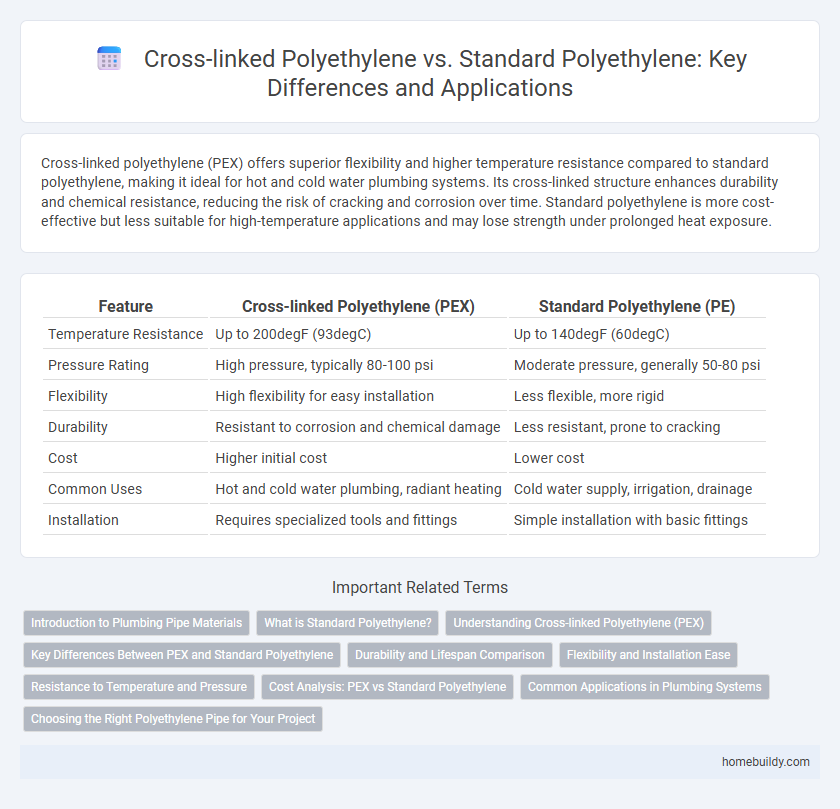Cross-linked polyethylene (PEX) offers superior flexibility and higher temperature resistance compared to standard polyethylene, making it ideal for hot and cold water plumbing systems. Its cross-linked structure enhances durability and chemical resistance, reducing the risk of cracking and corrosion over time. Standard polyethylene is more cost-effective but less suitable for high-temperature applications and may lose strength under prolonged heat exposure.
Table of Comparison
| Feature | Cross-linked Polyethylene (PEX) | Standard Polyethylene (PE) |
|---|---|---|
| Temperature Resistance | Up to 200degF (93degC) | Up to 140degF (60degC) |
| Pressure Rating | High pressure, typically 80-100 psi | Moderate pressure, generally 50-80 psi |
| Flexibility | High flexibility for easy installation | Less flexible, more rigid |
| Durability | Resistant to corrosion and chemical damage | Less resistant, prone to cracking |
| Cost | Higher initial cost | Lower cost |
| Common Uses | Hot and cold water plumbing, radiant heating | Cold water supply, irrigation, drainage |
| Installation | Requires specialized tools and fittings | Simple installation with basic fittings |
Introduction to Plumbing Pipe Materials
Cross-linked polyethylene (PEX) offers superior flexibility and higher temperature resistance compared to standard polyethylene, making it ideal for modern plumbing systems. Standard polyethylene pipes, while cost-effective and resistant to certain chemicals, lack the durability and pressure tolerance required for hot water delivery. Selecting PEX enhances durability, reduces installation time, and provides long-term reliability in residential and commercial plumbing applications.
What is Standard Polyethylene?
Standard polyethylene (PE) is a versatile thermoplastic polymer widely used in plumbing pipes for its durability, chemical resistance, and cost-effectiveness. It features a linear molecular structure, which provides good flexibility but lower temperature tolerance and pressure resistance compared to cross-linked polyethylene (PEX). Commonly utilized in water supply and irrigation systems, standard PE pipes are suitable for low to moderate temperature applications and environments with minimal thermal stress.
Understanding Cross-linked Polyethylene (PEX)
Cross-linked Polyethylene (PEX) is a durable and flexible plastic piping material commonly used in plumbing systems due to its resistance to high temperatures and chemical corrosion. Unlike standard polyethylene, PEX undergoes a cross-linking process, enhancing its strength, thermal stability, and longevity, making it suitable for hot and cold water distribution. Its ability to expand under pressure reduces the risk of bursting, offering a reliable alternative to traditional metal pipes.
Key Differences Between PEX and Standard Polyethylene
PEX (Cross-linked Polyethylene) offers superior durability and temperature resistance compared to standard polyethylene, making it ideal for hot and cold water plumbing systems. While standard polyethylene pipes tend to be more flexible and cost-effective, they lack the high-pressure tolerance and chemical resistance inherent in PEX pipes. The cross-linking process in PEX enhances its mechanical strength and longevity, resulting in reduced risk of pipe bursting and improved performance under varying environmental conditions.
Durability and Lifespan Comparison
Cross-linked polyethylene (PEX) pipes exhibit superior durability compared to standard polyethylene (PE) due to their enhanced resistance to temperature fluctuations, chemical exposure, and mechanical stress. PEX pipes can typically last 40 to 50 years under normal plumbing conditions, whereas standard polyethylene pipes generally have a shorter lifespan of around 20 to 25 years. The cross-linking process in PEX improves molecular bonding, resulting in increased strength and flexibility, which extends the plumbing system's overall lifespan.
Flexibility and Installation Ease
Cross-linked polyethylene (PEX) offers superior flexibility compared to standard polyethylene, allowing easier bending around corners without the need for additional fittings. This flexibility significantly simplifies installation in tight spaces, reducing labor time and costs. Standard polyethylene pipes, while durable, are more rigid and often require extra connectors, making the installation process more complex and time-consuming.
Resistance to Temperature and Pressure
Cross-linked polyethylene (PEX) offers superior resistance to higher temperatures and pressures compared to standard polyethylene, making it ideal for hot water plumbing applications. PEX pipes can typically withstand temperatures up to 200degF (93degC) and pressures exceeding 100 psi, whereas standard polyethylene is limited to lower temperature thresholds around 140degF (60degC) and lower pressure ratings. The cross-linking process enhances the polymer's structural integrity, improving its durability and making PEX a preferred choice for both residential and commercial plumbing systems.
Cost Analysis: PEX vs Standard Polyethylene
Cross-linked polyethylene (PEX) pipes generally have higher upfront costs compared to standard polyethylene pipes due to their advanced manufacturing process and enhanced durability. However, the long-term cost benefits of PEX include lower maintenance expenses and greater resistance to temperature fluctuations and chemicals, which reduce replacement frequency. Standard polyethylene pipes offer lower initial investment but may incur higher repair and replacement costs over time due to their susceptibility to cracking and degrading in harsh conditions.
Common Applications in Plumbing Systems
Cross-linked polyethylene (PEX) pipes are widely used in residential plumbing for hot and cold water distribution due to their flexibility, high temperature resistance, and durability against chemical corrosion. Standard polyethylene (PE) pipes are more commonly applied in cold water supply and irrigation systems where lower temperature tolerance and cost-effectiveness are prioritized. PEX's ability to withstand higher pressures and temperatures makes it ideal for radiant heating systems and potable water lines, while standard PE excels in underground water service lines and drainage systems.
Choosing the Right Polyethylene Pipe for Your Project
Cross-linked polyethylene (PEX) offers superior flexibility, chemical resistance, and temperature tolerance compared to standard polyethylene (PE), making it ideal for plumbing systems requiring durability and heat resilience. Standard polyethylene pipes are cost-effective and suitable for cold water applications and drainage systems where high temperature resistance is not critical. Selecting the right polyethylene pipe depends on project demands such as temperature range, pressure requirements, and environmental exposure.
Cross-linked Polyethylene vs Standard Polyethylene Infographic

 homebuildy.com
homebuildy.com